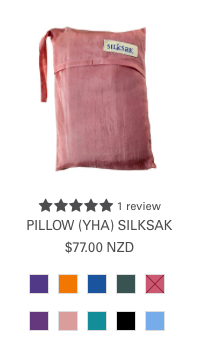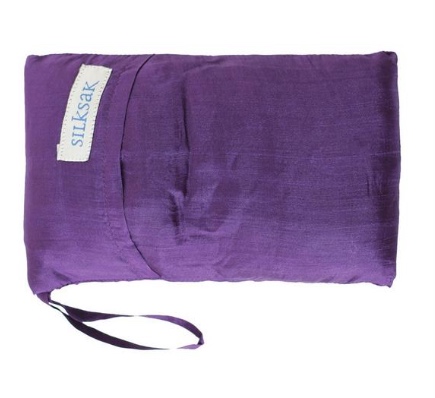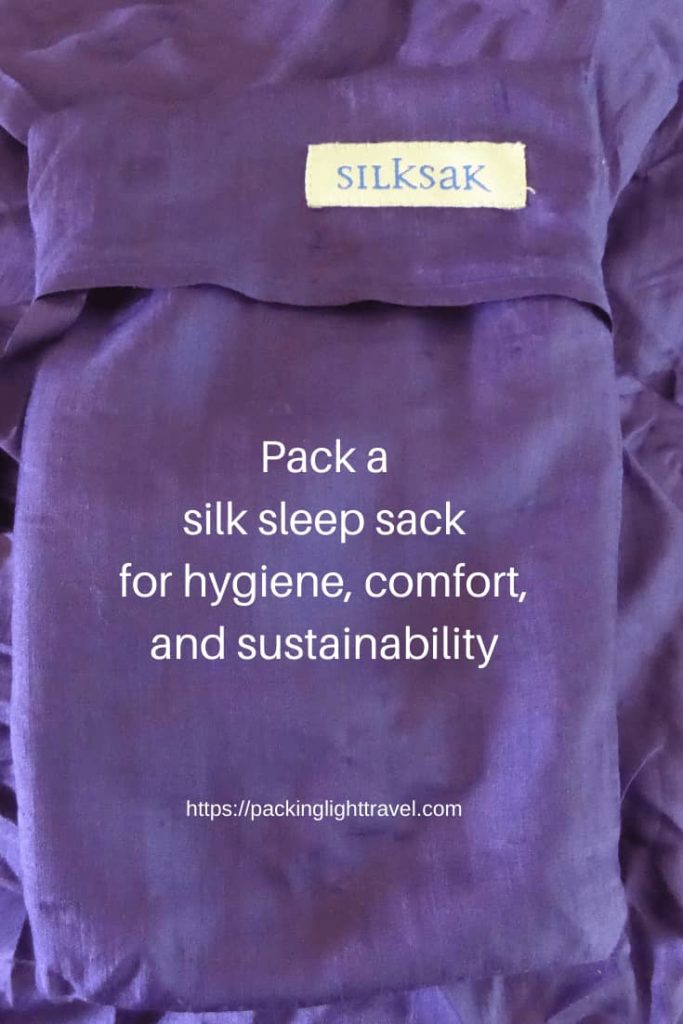Updated April 6, 2024
I confess. There are times at home when I’ve broken open my silk sleep sack because I crave sleeping in my personal cocoon of luxurious, natural silk. I bought it for camping, hiking huts, staying in hostels, and for times when the cleanliness of off-the-beaten-path accommodation might be suspect. These benefits aside, there are plenty of other reasons to pack a silk sleep sack while travelling at home and abroad.
Table of Contents
What is a silk sleep sack?
A silk sleep sack is a travel sheet or sleeping bag liner made of silk. Most liners come in mummy or rectangular styles. Some include an envelope to insert a pillow.
Why silk? What are the benefits?
- Silk is breathable, lightweight, packable, compact, and quick drying: perfect features for hikers and carry-on travellers.
- The extremely fine natural fabric feels soft against the skin. The smooth surface of silk is particularly important for sensitive skin or folks with skin allergies. Sericin, the natural gum that binds the silk cocoon together, contains many essential amino acids believed to contribute to healthy skin (much like lanolin in wool).
- Silk keeps skin dry. The hygroscopic silk fibre absorbs one third its own weight in moisture without feeling damp. The absorbed moisture is evaporated into the environment or absorbed by outer clothing or bedding layers.
- Silk is one of the safest fibres you can wear next to your skin because it is naturally flame resistant. Where synthetics melt, silk burns to harmless ash.
- Silk is biodegradable and will decompose easily in landfills.
Reasons to pack a silk sleep sack
1. Regulates body temperature
When travelling in warm climates, a silk sleep sack can be used alone as a perfect lightweight alternative to a regular sleeping bag or bedding. You’ll feel cool and comfortable as your silk sleep sack keeps your skin dry and your temperature down.
When used inside a sleeping bag, a silk sleep sack adds warmth, working with you to keep your body temperature even. It provides an insulating layer that traps warm air next to the body. It also offers warmth when a fan or air-conditioning unit is working overtime. Estimates are that a silk liner can add up to 10 degrees Fahrenheit (approximately 5 degrees Celsius) of warmth.
In a nutshell, silk keeps you warm if you’re cold and cool if you’re hot.
2. Protects against biting insects
The silk cocoon offers a measure of protection from biting insects. My silk sack came in handy in Marrakech when open windows of the hostel room let in a few bugs during the night.
If bed bugs are present, the tightly woven fabric may provide a barrier but there are no guarantees. Anecdotal evidence from hikers and travellers suggests that bites are reduced when a traveller is encased in a silk sleeping bag liner. The Mulberry Silk Company claims that silk bedding is inhospitable to bed bugs as the natural protein in silk repels both bed bugs and allergy-inducing bed mites.
3. Offers trusted bedding
Have you ever questioned the cleanliness or quality of the bedding at a hotel, hostel, or holiday accommodation? Do you wonder if the cleaning products will be harmful to your skin? A silk sleep sack, especially one with a pocket for a pillow, limits your contact with the provided bedding and any harsh detergents used in the laundering process..
Have you ever rented a sleeping bag? I did, for a three-day hike on New Zealand’s Banks Track. The hike was a small part of a three-month trip and renting a sleeping bag for 40 NZD was more appealing than packing my own and carrying it as dead weight for the other 85 days. The sleeping bags were laundered between guests but my silk sleep sack inside the rented sleeping bag added a significant amount of confidence that I’d made the right decision.
Do you trust the cleanliness of airplane blankets? If you think you’ll need extra warmth or privacy on a flight, toss your silk sleep sack in your personal bag just in case.
4. Saves money
Travellers on a limited budget or travelling for extended periods invariably choose budget accommodation at some point. Some charge extra for bedding and towels. Packing a silk sleep sack and travel towel result in considerable savings over time and offset the costs of the initial investment.
5. Can be useful when plans change
Being stuck in an airport overnight, or, heaven forbid, longer while waiting for your flight can be very uncomfortable. Slip into your silk sack for warmth, comfort, and to keep your purse, electronics, or other valuables hidden from prying eyes.
6. Protects a sleeping bag
Silk is recognized for its odour-resistant and moisture-wicking properties. It’s washable and dries quickly. Sleeping bags aren’t as easy to clean. After an energetic day of hiking with no shower in sight, oils from perspiration and general grunge from an active day transfer to the liner instead of the sleeping bag. When a silk sleep sack is consistently used as a liner between your body and the sleeping bag, the bag doesn’t need to be cleaned as frequently and this can extend its lifespan.
7. Oozes comfort
As I attempted to convey in the opening paragraph, the comfort of pure silk can’t be understated. After an exhausting day on the trails or an active travel day pounding city streets, sliding into the luxuriousness of 100% silk will set you up for a comfortable sleep. The soft silk is so soothing to the skin that it feels like a luxurious hug.
8. Silk is sustainable
Sericulture (silk production) is organic, sustainable, and earth-friendly. Silk caterpillars have an exclusive diet of mulberry leaves from trees that produce year after year. The trees are replaced after eight years, after which they’re not such vigorous growers and the leaves aren’t so tasty to caterpillars. Pesticides can’t be used on mulberry trees as silk caterpillars demand the purest and best quality leaves. Caterpillars are voracious eaters and their waste is used as fertilizer.
What are the disadvantages of a silk sleep sack?
- A sleep sack made of silk can be pricey. My approach is to buy quality that’s built to last. Liners made of synthetic fibres are cheaper but they don’t hold a candle to the quality and features of 100% silk. Buying quality and taking care of it translates into many years of faithful service and savings in the long run.
- Climbing out of a liner when nature calls (and climbing back in) isn’t as easy as negotiating your way in and out from under a flat sheet or duvet.
- Some silk liners can be machine washed but for longevity, hand washing is preferable.
My choice in a silk sleep sack
I purchased my silk sleep sack in 2013. After much research, I settled on the family-owned New Zealand company Silk Living, producers of the Silksak.
- I was attracted to the company’s commitment to sustainability, fair wages for the employees of its Asian-based suppliers, and its use of recycled packaging.
- Silk Living doesn’t add any treatments or flame retardants to improve anti-static, wash-and-wear, flame resistance, or anti-bacterial properties because their silk is already naturally endowed with these properties.
- I purchased the Pillow Silksak. What attracted me to this version is the built-in pillow envelope. A glorious layer of silk separates my head from the pillow nestled inside the pocket.
- Entry to the sleep sack is via a side-split opening with a gusset.
- A storage bag is attached. It will never go missing. I appreciate this feature.
- My Silksak takes up next to no room in my travel pack. It’s lightweight, compressible, compact, easily washed in the shower or a sink and dries very quickly.
- I like the rectangular (as opposed to mummy) style.
- Its specifications met my needs:

- Size: 86 cm (34 in) wide x 220 cm (87 in) long (including pillow slot)
- Weight: approximately 136 g (4.8 oz), including stuff bag
- 100% silk
- It comes in a multitude of colours
Silk Living has produced a fascinating video of the production process from the rearing of silkworms to the making of silk garments.
Where to buy
The Pillow Silksak is available from Silk Living’s online store. It currently (2024) costs USD 72 plus shipping costs that vary depending on the destination.
It’s also available from other suppliers in New Zealand.
If you found this post helpful, please share it by selecting one or more social media buttons. How about you? Do you travel with a silk sleep sack? Please share your thoughts in the comments. Thank you.
Care to pin it?
This post is neither sponsored nor solicited. I’ve not received any requests, instructions, or rewards from the manufacturer. I purchased the product for my own use and paid the full price.








Sleeping in a silk sack sounds so luxurious! I’ve heard of silk pillowcases but not a sleep sack! It sounds like my kind of thing, I’m definitely going to check it out! Thanks for the great guide!
I’ve never heard of a silk sack, but now I need one! My next trip will be long and I’m sure budget oriented, so I may need some of those protections!
I haven’t heard of this kind of sleeping bag before. Thanks for sharing this informative post – I’ll have to look into it more.
I’ve never heard of this before! It sounds like it would be very useful as my skin is quite sensitive to random things!!!
Wow I’ve never heard of silk sacks. But it sounds like a really good investment, I really liked the fact that it is useful when hiking and camping and can reduce bug bites!!
So this is definitely something I didn’t even know I needed?!? Appreciate you including the drawbacks, too, as it does seem a bit more high maintenance than other materials!
This sounds super handy for travel! Seems like the ideal investment and I love that it doesn’t take up a lot of space either! It sounds super cozy – something I never knew about yet something I don’t think I can live without haha. Thanks for letting know about this!
This is so interesting. I’d like to see a picture of what it looks like with someone in it.
I haven’t heard of a silk sleep sack before but feel it’s something I need in my life after reading this. Thanks for sharing.
I can’t wait to try one of these. This was the first time I had heard of a silk sleep sack. It sounds wonderful!